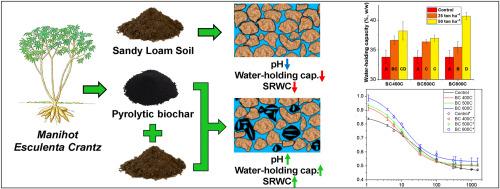Cassava's harvest residue biochar from rotary kiln pyrolysis: Effects on sandy loam soil properties and maize growth
IF 5.8
2区 生物学
Q1 AGRICULTURAL ENGINEERING
引用次数: 0
Abstract
Cassava shoot system (CSS) biomass is a smart and despised raw material for biochar production. Commonly, cassava roots and their husk are most exploited as feedstock for the thermoconversion process. In this research, we proposed the production of biochar from CSS in a continuous pyrolysis reactor at temperatures of 400 °C, 500 °C, and 600 °C, searching for added value to this agricultural residue and to produce a soil amendment material with good water retention potential. CSS-biochars have their effects tested on sandy loam soil at 25- and 50-ton ha−1 application rates. Considering soil amendment and carbon sequestration purposes of biochars, the volatile matter, fixed carbon, and ash content are important parameters to be considered. Higher temperature produces more stable and less organic functionalized biochars, measured by the O/C values from 0.21 to 0.03 and H/C from 0.96 to 0.46. Biochars’ pH increases directly with the ash content and significantly alters the soil pH, increasing it from 5.0 to 6.0 with BC500C and BC600C at a rate of 50 tons ha−1. At the same application rate, BC400C and BC600C presented an increase in water-holding capacity of 13 % and 20 % compared with the control sample, respectively. Overall, the matric potential view for all application rates only the CSS-biochar produced at 600 °C demonstrated superior water retention compared to the reference control. An important observed aspect is the no significant impact of biochar on the maize germination step in pot experiments.

回转窑热解木薯收获渣生物炭:对砂壤土性质和玉米生长的影响
木薯芽系统(CSS)生物质是一种智能和轻视的生物炭生产原料。通常,木薯根和它们的外壳最被用作热转化过程的原料。在本研究中,我们提出在400℃、500℃和600℃的连续热解反应器中利用CSS生产生物炭,寻找其农业残留物的附加值,并生产出具有良好保水潜力的土壤改良剂材料。css -生物炭在沙质壤土上以25和50吨公顷- 1的施用量进行了效果测试。考虑到生物炭的土壤改良剂和固碳作用,挥发分、固定碳和灰分是需要考虑的重要参数。温度越高,产生的生物炭越稳定,有机功能化程度越低,O/C值为0.21 ~ 0.03,H/C值为0.96 ~ 0.46。生物炭的pH值随灰分含量的增加而直接增加,并显著改变土壤pH值,添加BC500C和BC600C后,土壤pH值以50 t ha - 1的速率从5.0提高到6.0。在相同施用量下,BC400C和BC600C的持水能力分别比对照样品提高13%和20%。总的来说,在所有施用速率下,只有在600°C下生产的css -生物炭与对照相比表现出更好的保水能力。在盆栽试验中观察到的一个重要方面是生物炭对玉米发芽步骤没有显著影响。
本文章由计算机程序翻译,如有差异,请以英文原文为准。
求助全文
约1分钟内获得全文
求助全文
来源期刊

Biomass & Bioenergy
工程技术-能源与燃料
CiteScore
11.50
自引率
3.30%
发文量
258
审稿时长
60 days
期刊介绍:
Biomass & Bioenergy is an international journal publishing original research papers and short communications, review articles and case studies on biological resources, chemical and biological processes, and biomass products for new renewable sources of energy and materials.
The scope of the journal extends to the environmental, management and economic aspects of biomass and bioenergy.
Key areas covered by the journal:
• Biomass: sources, energy crop production processes, genetic improvements, composition. Please note that research on these biomass subjects must be linked directly to bioenergy generation.
• Biological Residues: residues/rests from agricultural production, forestry and plantations (palm, sugar etc), processing industries, and municipal sources (MSW). Papers on the use of biomass residues through innovative processes/technological novelty and/or consideration of feedstock/system sustainability (or unsustainability) are welcomed. However waste treatment processes and pollution control or mitigation which are only tangentially related to bioenergy are not in the scope of the journal, as they are more suited to publications in the environmental arena. Papers that describe conventional waste streams (ie well described in existing literature) that do not empirically address ''new'' added value from the process are not suitable for submission to the journal.
• Bioenergy Processes: fermentations, thermochemical conversions, liquid and gaseous fuels, and petrochemical substitutes
• Bioenergy Utilization: direct combustion, gasification, electricity production, chemical processes, and by-product remediation
• Biomass and the Environment: carbon cycle, the net energy efficiency of bioenergy systems, assessment of sustainability, and biodiversity issues.
 求助内容:
求助内容: 应助结果提醒方式:
应助结果提醒方式:


